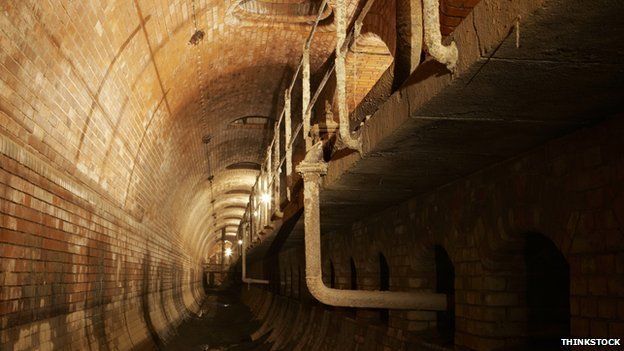Sewer sensors to sniff out bomb ingredients
- Published

Hidden beneath the streets of Stockholm, the city's sewage plant is working at full throttle.
As we head into one of the tunnels, the stench is overpowering: through here, the waste of 700,000 people flows.
But sewer systems have been earmarked for a new use: the fight against terrorism is moving underground.
"We have a bunch of electrodes, and immerse them in the sewage," explains Hans Oennerud.
He has been coordinating an EU-funded project called Emphasis to design a network of hi-tech sensors for sewers.
The devices can detect the chemicals that are used to make homemade explosives, which, as Dr Oennerud explains, are likely to end up in the wastewater.
Hans Oennerud explains how the Emphasis project works
"If you make homemade explosives or bombs, you need a place to be, you need to use some equipment, and some chemicals," he explains.
"In the process there could be a need to rinse equipment or pour it down the drain - and this is something we want to take advantage of."
The sensors can detect minute traces of the bomb ingredients, recording their concentration, the time they were found and their location.
This information is then sent out to police.
The team there has created a replica of a bomb lab, where they are making explosives to put the devices to the test.
Henric Oestmark is the research director of energetic materials - or, as he puts it, anything that goes bang.
"We want to test it as realistically as possible," he says.
"If you have a normal lab, you have very clean air, for example. You need to simulate what is happening in real life if you are going to find a bomb factory."
Most homemade bombs are hydrogen peroxide or fertiliser-based, he says.
"They have chemicals you buy in a normal supermarket, and they are using them to make bombs."
The scientists here are not just interested in what ends up down the drain, fumes from the manufacturing process also leak out into the air.
And in addition to the sewer devices, they've fitted sensors to rooftops and even cars.
This network, Prof Oestmark says, could help to pinpoint where illegal activity is taking place. The technology could also be used to find drug labs or places where chemical weapons are being made, he adds.
While the sensors are in their prototype phase, they have attracted interest from around the world.
Authorities, including the UK's Ministry of Defence and the US Department of Homeland Security, have come to Sweden to watch a demonstration of the sensors at work.
Torbjoern Liwang, from the Swedish police, says the use of homemade explosives is a growing concern.
"We've seen attacks in Madrid, London and Oslo and in many other places. It is a big problem," he tells BBC News.
"I think one of the causes is because military and civilian explosives are harder to get hold of so, the terrorists make their own instead.
"The criminals and terrorists are ahead of us. They're really good at finding new ways to create bombs…. and we need new technologies, new ways of finding bomb factories."
Prof Oestmark says that the sensors could provide vital intelligence to the police and potentially save lives.
"With the London bombings in 2005, the bombs were made in Leeds, and the police had some intelligence," he says.
"If these sorts of sensor were deployed, you would have had a fair chance of detecting the bombs."
- Published21 March 2014
- Published25 March 2011
- Published7 June 2010
- Published12 September 2014